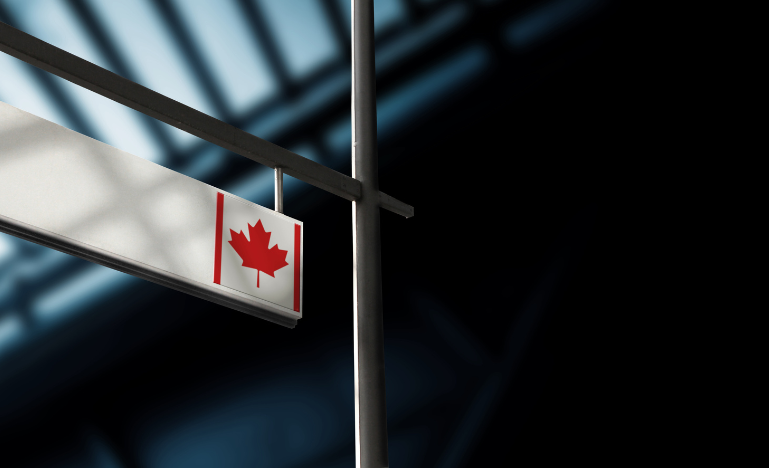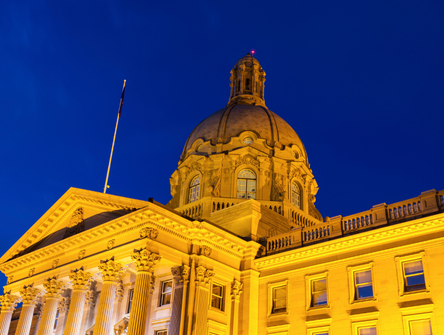Craintes exagérées d’une vague d’immigration
Les experts soutiennent que nous n’assisterons pas à la même vague de migrants à la frontière que par le passé, mais le Canada devra faire des choix difficiles en matière d’immigration au cours des quatre prochaines années

Les gros titres déprimants ne manquent pas sur les projets de Donald Trump concernant les migrants irréguliers aux États-Unis : menaces d’envoyer des familles dans des camps d’internement, d’expulser 12 millions de sans-papiers et de mettre fin au statut de protection temporaire pour les réfugiés en danger.
Au Canada, de nombreux reportages ont porté sur la perspective d’une « poussée » massive de l’immigration clandestine à la frontière – une situation à la chemin Roxham. Il est réconfortant alors de savoir qu’un spécialiste en immigration estime que les Canadiens peuvent se rassurer.
« Non, nous n’allons pas assister à la même vague de migration aux frontières que par le passé », dit Aisling Bondy, présidente de l’Association canadienne des avocats et avocates en droit des réfugiés.
« Les gens semblent oublier que l’Entente sur les tiers pays sûrs a été modifiée. »
L’entente, signée en 2004, stipule que les personnes qui demandent le statut de réfugié aux États-Unis ou au Canada doivent (dans la plupart des cas) déposer leur demande dans le premier des deux pays où elles arrivent.
En 2023, les États-Unis et le Canada ont révisé le traité pour étendre ses dispositions aux ports d’entrée irréguliers comme le chemin Roxham. Actuellement, les migrants peuvent demander l’asile au Canada s’ils parviennent à entrer dans le pays et à y rester sans être détectés pendant 14 jours (une option qu’Ottawa envisagerait maintenant d’éliminer). Toutefois, cela est « vraiment, vraiment difficile à faire », avoue Me Bondy.
« Et pourtant, les gens vont tenter leur chance en prenant d’énormes risques personnels, parce qu’ils n’ont pas d’autres options et sont désespérés. »
Le gouvernement précise que, depuis les changements intervenus en 2023, le nombre de demandes d’asile déposées par des personnes traversant illégalement la frontière est passé d’une moyenne de 165 par jour à 12.
Même si les craintes d’une vague de migrants clandestins s’avèrent exagérées, le Canada devra encore faire des choix difficiles en matière d’immigration au cours des quatre prochaines années. S’il joue bien son jeu, le pays pourrait même en récolter quelques avantages.
Tout d’abord, le Canada a peu de raisons de penser que la nouvelle administration Trump considérera l’Entente sur les tiers pays sûrs comme sacro-sainte.
« L’Entente sur les tiers pays sûrs était dans l’intérêt du Canada depuis le début », fait remarquer Audrey Macklin, titulaire de la Chaire en droits de la personne de la faculté de droit de l’Université de Toronto. « Cela n’a jamais été quelque chose que les États-Unis voulaient ou dont ils avaient besoin.
« Et l’entente est vulnérable aux manœuvres politiques. »
En vertu de l’accord, chaque pays peut la suspendre à court terme pour une durée maximale d’un an ou la résilier complètement avec un préavis d’un an. Elle dit qu’elle n’a pas de mal à penser que Donald Trump fasse l’une ou l’autre de ces choses si un nombre important de personnes aux États-Unis tentent d’entrer au Canada.
« Posez-vous la question : pourquoi Donald Trump accorderait-il un soutien politique à une entente qui renvoie les migrants aux États-Unis? »
L’entente pourrait prendre l’eau, même si Washington ne l’élimine pas carrément. Lorsque la Cour suprême a confirmé la constitutionnalité de l’entente l’année dernière, elle a soutenu que des « soupapes de sécurité » – des exemptions intégrées dans celle-ci – peuvent protéger les demandeurs d’asile contre le renvoi vers des conditions dangereuses aux États-Unis.
« Toutefois, l’Entente sur les tiers pays sûrs ne précise pas quelles sont ces exceptions, rappelle Aisling Bondy. Nous ne savons pas quelles circonstances particulières permettraient aux agents des services frontaliers d’admettre certaines personnes au Canada. »
Certains profils de demandeurs sont reconnus comme ayant droit au statut de réfugié au Canada, mais pas selon la jurisprudence américaine. Cela inclut notamment les femmes qui fuient la violence domestique.
« Nous avons besoin de précisions. »
Le concept de « soupapes de sécurité » pourrait également perdre sa raison d’être si Donald Trump tient sa promesse de faire la vie dure aux irréguliers avant leur expulsion en les incarcérant dans des camps d’internement.
« Si les États-Unis ne sont plus un pays sûr, la condition préalable à l’Entente sur les tiers pays sûrs disparaît et le pays devient beaucoup plus vulnérable à une contestation judiciaire ici », explique Me Macklin.
Modifier l’entente pour l’appliquer aux passages frontaliers irréguliers équivalait à créer « un plan de relance gouvernemental pour le trafic de personnes », explique Me Macklin. Tout sans-papiers qui tente de voyager vers le Nord pour se mettre à l’abri en vertu de la disposition des 14 jours met sa vie entre les mains de réseaux criminels – et le renforcement de la frontière n’est pas vraiment une option pratique, peu importe l’argent qu’Ottawa dépense sur l’achat de drones. »
« Parlons-nous sérieusement de militariser des milliers de kilomètres de frontière et de maintenir un accord qui stimule le trafic de personnes, demande-t-elle. Voulons-nous vraiment que davantage de gens meurent de froid? »
En décembre, le gouvernement fédéral a annoncé des dépenses de 1,3 milliard de dollars dans le cadre de l’énoncé économique de l’automne. L’initiative canadienne visant à renforcer la sécurité aux frontières intervient alors que Donald Trump menace d’imposer des droits de douane de 25 % sur toutes les importations canadiennes, en raison de ses inquiétudes concernant le flux d’immigrants illégaux et le trafic de substances illicites.
Cette semaine, quelques jours avant l’investiture présidentielle, le gouvernement fédéral a annoncé que 60 nouveaux drones et deux hélicoptères Black Hawk feront partie des patrouilles frontalières renforcées, ainsi que de nouvelles tours de surveillance aérienne. Le ministre de l’Immigration, Marc Miller, a également dit que le Canada partagerait davantage de renseignements personnels sur les résidents permanents qui traversent la frontière avec les autorités américaines.
Malgré le sort de l’Entente sur les tiers pays sûrs, le Canada a besoin d’une réforme de l’immigration pour éviter que le système ne devienne un enjeu politique incontournable en période de crise économique, selon Eddie Kadri de Kadri Law, un cabinet juridique spécialisé en droit de l’immigration basé à Windsor, e Ontario.
« Ce dont nous avons le plus besoin, c’est que le gouvernement abandonne cette approche pendulaire en matière d’immigration, qui une journée oscille vers l’ouverture, puis le lendemain vers la répression », dit-il.
« Le Canada a besoin d’immigrants. Nous ne pouvons pas maintenir notre niveau de vie sans eux. »
La priorité devrait être accordée à l’immigration qui fera croître notre économie et permettra de remédier aux pénuries de main-d’œuvre, précise-t-il.
« C’est la seule façon pour nous d’assumer nos responsabilités humanitaires. À l’heure actuelle, la confiance du public dans le système s’érode. »
Me Kadri estime que les gouvernements canadiens devraient s’efforcer de bâtir l’infrastructure qui soutient l’immigration, notamment les services de santé et le logement, tout en gardant le système suffisamment flexible pour répondre aux changements soudains dans le flux d’immigration.
« Le simple fait de rapprocher les taux [d’immigration] aux mises en chantier de logements revient à faire l’examen d’un problème incroyablement complexe sous un seul angle », dit-il.
« Nous devons veiller à ce que la politique d’immigration en temps réel puisse s’adapter rapidement pour répondre à des situations uniques qui surviennent ou à des circonstances urgentes qui demandent de la souplesse. »
Le système d’immigration et les tribunaux qui le soutiennent ont un manque criant de ressources. La Cour fédérale prévient que le nombre de dossiers d’immigration à traiter devrait augmenter de 50 % cette année, tout en signalant un déficit budgétaire annuel de 35 millions de dollars.
L’arriéré dans les demandes non traitées à Immigration, Réfugiés et Citoyenneté Canada s’élevait à 1 097 000 en septembre, soit une augmentation de 1,73 % par rapport au mois précédent. Quoi qu’il advienne au cours des quatre prochaines années, la pression sur le gouvernement fédéral pour augmenter le financement des ministères et simplifier le processus pour les cas simples sera immense.
Le Canada pourrait probablement en faire davantage pour accueillir les citoyens américains qui cherchent à fuir la nouvelle administration, consternés par ses politiques ou craignant d’être les prochains à y passer.
Evan Green, associé directeur chez Green and Spiegel et spécialiste du droit de la citoyenneté et de l’immigration, a reçu des demandes de renseignements d’Américains bien nantis souhaitant devenir Canadiens.
« Il peut s’agir d’Américains ayant des antécédents familiaux liés à la guerre ou à la persécution. Il peut aussi s’agir de personnes LGBT et de leurs familles », précise-t-il.
« Certaines de ces personnes ont une crainte bien légitime que la nouvelle administration s’en prenne à eux, les persécute, parce que c’est ce que Donald Trump a promis de faire. Les personnes qui m’ont contacté sont des personnalités publiques bien connues. »
Selon Me Green, durant la dernière administration Trump, le Canada a accueilli de nombreux travailleurs américains en haute technologie qui n’avaient pas été autorisés à travailler aux États-Unis. Ce dont nous avons besoin maintenant, dit-il, c’est d’un processus d’immigration spécial pour « les personnes plus âgées, les gens du secteur artistique et les travailleurs indépendants ».
« Le Canada n’a défini aucune voie d’immigration particulière. Par exemple, Meryl Streep ne serait pas jugée admissible aux fins de l’immigration au Canada. Taylor Swift non plus, » mentionne Me Green.
Le Canada devrait créer des voies particulières en matière d’immigration, semblable au visa de travailleur temporaire O-1 aux États-Unis. Ces dispositions sont réservées aux personnes ayant fait preuve de « capacités extraordinaires » dans les domaines des sciences, des arts, de l’éducation, des affaires ou du sport.
« Pour le moment, le Canada ne dispose d’aucune disposition similaire, dit-il. Il s’agit d’une véritable ouverture nous permettant de recruter des talents de renommée mondiale. Une occasion formidable pour le Canada. »


